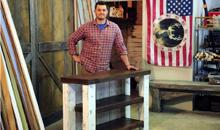Finishing With Wood Preservatives
The application of various wood preservatives, for example waterborne and organic-borne type, can exert specific effect on the surface performance and properties of different coated wood species. By Turgay Ozdemir, Ali Temiz, and Ismail Aydin, Department of Forest Industry Engineering, Karadeniz Technical University
Wood and wood-based materials have been extenseively used in outdoor and indoor applications due to their abundance and versatility. Wood, commonly used in outdoor applications, is preferred for proper protection and best service life against decay, insects, weathering, and dimensional instability. The term of wood weathering describes combination of UV-degradation, moisture, heat, and atmospheric pollutants (e.g.,acid rain, ozone, nitrogen oxides, and sulphur dioxide).
Wood has several chromophoric functional groups such as hydroxyl, carbonyl, carboxyl groups, and aromatic and phenolic groups. The effect of wood weathering is manifested by initial wood surface colour changes, followed by loss of gloss, roughening and checking. These changes are due to modification of chromophoric groups of wood and formation of coloured quinines-like component.
Wood materials can be protected against these factors by applying wood treatment process and/or wood finishing. The first option is the treatment with wood preservatives. The major wood preservatives used for treatment process are creosote, pentachlorophenol, chromated copper arsenate (CCA), and other copper-based wood preservatives such as alkaline copper quaternary (ACQ) and amine copper azole (CA).
The second option is applying coatings. A variety of finishes or coatings can be applied to wood. Finishes can be divided into two groups: (1) opaque coatings, such as paints and solid-color stains and (2) natural finishes, such as water repellents, oils, and semitransparent penetrating stains.
Performance of wood coatings depends on several factors such as wooden substrate itself, humidity, moisture content of wood, temperature, environmental pollutants, and microorganisms. Photo-induced degradation of wood caused shorter service life of wood coatings. This is due to penetration of UV light through transparent finishes and degradation of the bonding mechanism between finishes and wood.
The performance of wood coatings can be improved by different strategies. One option is the addition UV absorbers and radical scavengers. The second approach is treatment of wood materials with wood preservatives since these preservatives can inhibit photo-induced degradation and increase durability against fungi and insects.
The most common wood preservative used is the chromated copper arsenate (CCA) but it contains pentavalent arsenic which is hazardous to human and environment. The effect of CCA on the wood weathering and its combination with the wood coatings are well-established. However, there is still research needed on the performance of new generation preservatives which are copper based but chrome- and arsenic-free.
A study was carried out to determining the effect of new generation wood preservatives on the performance of wood coating. Scots pine, beech, and chestnut samples were treated with CCA, Tanalith E, boric acid, and Immersol and coated with cellulosic-based finishing.

Surface Treatment And Test Methods
Sapwood of scots pine, oriental beech and chestnut specimens (300mm × 100mm × 15 mm along the grain) were impregnated with aqueous solution of 2% CCA, 2% Tanalith E, and 1% boric acid and Immersol aqua vacuum (625 mm Hg) over the blocks was applied for 45 min.
After vacuum, the wood samples were kept in the treatment solution for 60 minutes in atmospheric conditions. The samples were then removed from the treatment solution, wiped lightly to remove solution from the wood surface, and weighed to determine their gross retentions. Retention values were chosen according to producers’ suggestions.
After the treatment process, the samples treated with copper-based wood preservatives were then wrapped in plastic bag for a week at the room temperature for fixation.
The surfaces of the samples were sanded with sandpapers of 100 and 150 grid size. Cellulose varnish type was commercially obtained from supplier. The coating was applied by spraying with approximate varnish application amount of 120 g/sq m. The coating was applied to surface as two base layers and one top layer.
Surface roughness values of the treated and untreated samples were determined by using a stylus type profilometer. Detector tip radius was 5 μm while cut-off length was 2.5 mm and sampling length was 12.5 mm in the surface roughness measurements. Three roughness parameters including the average roughness, the mean peak-to-valley height, and the maximum roughness were used to evaluate surface roughness of the samples according to DIN 4768.
A total of fifteen replicate measurements were taken from each untreated and treated wood. The dimensions of specimens used for surfaces roughness measurements were 10 cm by 10 cm. All measurements were made across the grain orientation.
Dry coating thickness of samples treated wood preservatives and untreated (control) was determined by using the dry film thickness apparatus according to ASTM D 4138.
Adhesion strength based on the Pull-off methods was determined according to ASTM D 4541. Twenty different points with a contact area of 20 mm circles were taken from each side of the treated and untreated samples. The Ericksen Adhesion-525 MC tester with a head glued to the surface of the samples was employed for the test. The testing device runs at a constant speed of 10 cm/min and applies tension force to the surface layer by pulling the coating from the wood surface.
Gloss measurement was carried out according to standard test of ISO 2813. Ten replicates with dimensions of 100mm X 100mm X 15 mm were used. During the measurements, the 60° geometry was applied to all coated samples.
Scratch resistance test was done according to DIN 68861. A special scratch diamond with a hemispherical point was used with different weight forces ranging from 1.5N to 4.0 N. Five replicates (100mm × 100mm × 15 mm) for each group were used for determining the resistance of scratch.
Abrasion test was carried out according to DIN 68861. The taber abraser consists of a horizontal plate on which the test samples with the dimensions of 100mm × 100mm × 15 mm were placed flat. Five replicates were used. The plate turned at a speed of 55 ± 6 min−1. Above the plate, two abrasive discs with rubber coating were mounted to a press that can exert a force of 5.5 ± 0.2 onto the test piece.
Strips of sandpaper were attached to the rubber coating. The number of revolutions necessary to reach the final point then determines the abrasion as follows: (a) Up to 50 percent of the wood has been worn away.(b)In case of self-colored surface, the color disappears, and/or the under surface was visible.
Study Result
The multifactor analysis of variance was used for comparing the results obtained from experiments. The Duncan test was used to compare mean values of variance sources.
The surfaces of pine control samples were found to be smoother than those of beech and chestnut control samples. The surface roughness differences between pine wood as softwood and beech and chestnut woods as hardwoods could be related to their density differences.
Among hardwoods, chestnut samples showed higher surface roughness than beech wood. Chestnut is ring-porous tree while beech wood is diffuse-porous tree. Therefore, vessels in chestnut tree are located mainly in earlywood section which causes higher surface roughness while vessels in beech wood are located throughout cross section which causes smoother surface.
The highest average surface roughness value (Rz) was measured on chestnut samples treated with boric acid (77.37 μm) and the lowest result was obtained for pine samples treated with solvent-based wood preservative (16.44 μm).
Generally, waterborne wood preservatives increased surface roughness of wood, while on the contrary, organic-based ones decreased it.
Effects of wood preservatives on the surface roughness of wood depend on wood species and wood preservative types used due to anatomical differences between softwood and hardwood, chemical composition of wood preservatives, and bonding mechanism with wood.
It was reported that waterborne wood preservatives increased surface roughness of wood due to increased surface porosity and raised fibres on the surface of wood. However, organic-borne wood preservatives decreased surface roughness of wood due to the filled surface cavity and decreased surface porosity.
The highest surface roughness value is obtained for samples treated with boric acid ( Rz = 43.57μm) since boric acid crystals were formed on the wood surfaces after impregnation.
According to a study, the surface of CCA-treated red maple wood was found to be rougher than that of untreated wood. However, no marked changes in the surface roughness of alder and beech wood after borax and boric acid treatment were found. In another experiment, it was also reported that impregnation with copper-based preservatives (CCA, ACQ, Tanalith E, and Wolmanit CX) increased the values of surface roughness when compared with untreated (control) samples.
Dry film thickness of treated and untreated wood species was found as 90 μm for all group and wood species. No differences were found between untreated and treated wood samples.
The highest adhesion strengths were determined on beech-treated and beech-untreated wood samples while the lowest adhesion strength was obtained on pine samples. These differences can be attributed to wood properties and density differences (higher density of beech wood).
Beech wood which has diffuse-porous structure showed better absorption of the varnish, which, in turn, caused higher magnitude of interaction between wood and varnishes. In addition, varnishes applied on beech and chestnut samples had deeper penetration than that of pine samples due to their more porous structures.
According to the adhesion strength test, organic-based wood preservative showed the lowest adhesion result among the other wood preservatives due to decreasing bonding capacity of coatings and wood. However, boric acid treatment provided increasing adhesion strength for all wood species used.
The increasing adhesion strength of boric acid treatment could be attributed to higher mechanical interlocking mechanism of adhesion caused by increased surface roughness of boric acid-treated wood. The decreasing adhesion test for treated samples could be related to poor wetting properties after impregnation.
The highest value of the gloss measurement was determined on organic-based wood preservative treatment. The waterborne wood preservatives of control groups (untreated) decreased gloss values while organic-based wood preservative increased them. The reason for higher gloss value of organic-borne wood preservative could be better filled surface cavity that resulted in better reflection of light.
However, water-based wood preservatives increased surface porosity and raised fibres decreased gloss value. Regarding to wood species, pine untreated samples showed highest gloss value while the lowest gloss value was obtained for beech-untreated samples. The differences between gloss values are due to the anatomical and chemical structure of softwood and hardwoods.
As expected, there were no major differences between wood species and treatment preservatives as scratch resistance depended on only properties of the coating, that is, components, hardness of coating film, and so forth.
Regarding to the abrasion resistance test the untreated beech samples had higher abrasion resistance values (37.50 rpm) than those of the untreated pine (33.00 rpm) and chestnut (35.83 rpm). This is due to the wood properties such as density and permeability. Wood preservatives increased abrasion resistance for all groups. Remaining film layer on the surface caused to an increase in the abrasion resistance.
Conclusion
This study tested the effect of waterborne and organic-based wood preservatives on the performance of finishing. The major findings of the study can be summarised as follows: Firstly, surface roughness values changed depending on wood species due to the anatomical differences between softwood and hardwood.
Secondly, adhesion properties of treated wood depended on the chemical composition of preservatives. Organic-based wood preservative (Immersol aqua) decreased the adhesion properties because of the poor adhesion properties after impregnation. While organic-based wood preservative increased the gloss value, the waterborne wood preservatives decreased the gloss value.
Thirdly, wood preservatives did not affect the scratch resistance which was disclosed to depend on the coating properties. Fourthly, treatment with both waterborne and organic-based wood preservatives increased the abrasion strength significantly.(fdmasia)





 沪公网安备31010402003309号
沪公网安备31010402003309号



